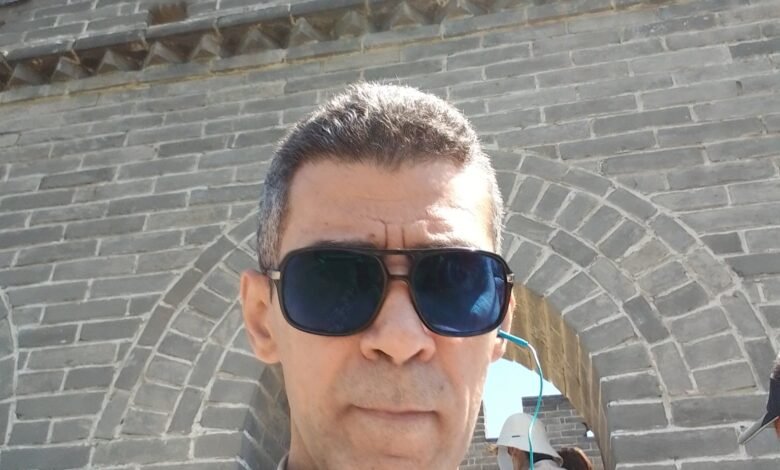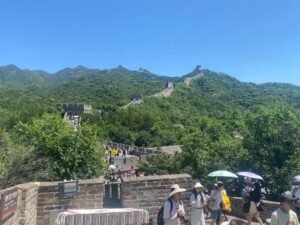العالم الآثاري المصري الدكتور محمد شبانة يكتب: سلسلة رحلتي إلى الصين – سور الصين العظيم ذاكرة مقاومة وصمود حضاري (4)


من أول وأهم الزيارات الميدانية التي قمنا بها تحت رعاية أكاديمية الصين للتراث الثقافي أثناء فترة الندوة العلمية (السيمنار) كانت زيارة المعلم التاريخي الأهم في الصين وأعني به سور الصين العظيم وهو من أعظم الإنجازات الهندسية في تاريخ البشرية، ويُعد رمزًا للقوة والتنظيم في الحضارة الصينية بدأ بناؤه في القرن الثالث قبل الميلاد في عهد الإمبراطور تشين شي هوانغ، أول موحد للصين، بهدف صد الغزوات من القبائل الشمالية كالهون والمغول.
لم يُبنَ السور دفعة واحدة، بل مر بمراحل متعددة على مدى أكثر من ألفي عام، إذ ساهمت عدة أسر حاكمة في توسيعه وتعزيزه في عهد أسرة هان، امتد السور غربًا لحماية طرق التجارة، خصوصًا طريق الحرير، بينما أُهمل في بعض الفترات بسبب الضعف السياسي.
أما في عهد أسرة مينغ (1368–1644م)، فقد شهد السور أضخم أعمال التوسعة والتقوية، حيث استُخدمت فيه الحجارة والطوب بشكل واسع يمتد السور لأكثر من 21,000 كيلومتر، من شرق الصين عند خليج بوهاي إلى صحراء جوبي في الغرب، متكاملًا مع التضاريس الوعرة
بُني باستخدام مواد محلية مثل الطين المدكوك، الحجارة، الخشب، والطوب، حسب طبيعة الأرض والموقع الجغرافي.
يضم السور عناصر معمارية بارزة كالأبراج الحصينة، القلاع، الثكنات، ومسارات للدوريات، مما جعله حصنًا دفاعيًا متكاملًازُوّد أيضًا بأبراج مراقبة تُستخدم لإرسال الإشارات بالدخان أو النار، ما شكّل نظام إنذار مبكر متقدمًا نسبيًا لعصره.

تميزت زخرفته بالبساطة، حيث غلب عليها الطابع العسكري الوظيفي لا الجمالي، باستثناء بعض البوابات التي زُينت بنقوش رمزية.
يمثل السور مثالًا رائعًا على قدرة الإنسان على تسخير الجغرافيا لأغراض استراتيجية، إذ يسير فوق الجبال والوديان بانسجام.
ومن سماته المعمارية الضخامة، الاستمرارية، والتكامل مع البيئة، إلى جانب القدرة على التنظيم الدفاعي والتنسيق بين الحاميات.
يُظهر السور تطور الفكر العسكري والهندسي في الصين القديمة، ويعكس أهمية الأمن والدفاع في فكر الحكام الصينيين عبر العصوريُعتبر اليوم من عجائب الدنيا السبع الجديدة، وموقعًا تراثيًا عالميًا يجذب ملايين الزوار من مختلف أنحاء العالم.
سور الصين العظيم ليس مجرد جدار، بل سجل تاريخي يعكس صمود أمة وتطورها عبر قرون من التحديات والإنجازات. (يُتبع)

My Journey to China Series: The Great Wall of China: Memory of Resistance and Cultural Endurance (4) by Dr. Mohamed Shabana, Egyptian Archaeologist.
One of the first and most important field visits we conducted under the auspices of the China Academy of Cultural Heritage during the scientific seminar was a visit to the most significant historical site in China, namely the Great Wall of China.
The Great Wall of China is one of the greatest Architectural achievements in human history and stands as a symbol of strength and organization in Chinese civilization.
Its construction began in the 3rd century BCE during the reign of Emperor Qin Shi Huang, the first unifier of China, with the aim of repelling invasions from northern tribes such as the Huns and Mongols.
The wall was not built all at once; rather, it went through multiple stages of expansion and reinforcement over more than two millennia.
During the Han Dynasty, it was extended westward to protect trade routes, especially the Silk Road, while in some periods it was neglected due to political weakness.
Under the Ming Dynasty (1368–1644 CE), the wall saw its most significant expansions and fortifications, using stone and brick extensively.
It stretches over 21,000 kilometers, from eastern China near the Bohai Gulf to the Gobi Desert in the west, blending with the rugged terrain.
The wall was built using local materials such as rammed earth, stones, wood, and bricks, depending on the geography of each region.
It includes key architectural elements such as fortified towers, castles, barracks, and patrol paths, forming an integrated defense system.
Watchtowers were equipped to send smoke or fire signals, creating a relatively advanced early warning network for its time.
Its decoration was simple and functional, with a military focus, although some gates were adorned with symbolic carvings.
The wall is a remarkable example of human ability to adapt geography for strategic purposes, running across mountains and valleys in harmony.
It is characterized by its scale, continuity, environmental integration, and its role in organizing defensive coordination.
The Great Wall reflects the evolution of military and engineering thought in ancient China and highlights the importance of security to Chinese rulers.
Today, it is considered one of the New Seven Wonders of the World and a UNESCO World Heritage Site that attracts millions of visitors annually.
The Great Wall is not just a barrier, but a historical record of a nation’s resilience and development through centuries of challenges and achievements. …to be continued.








